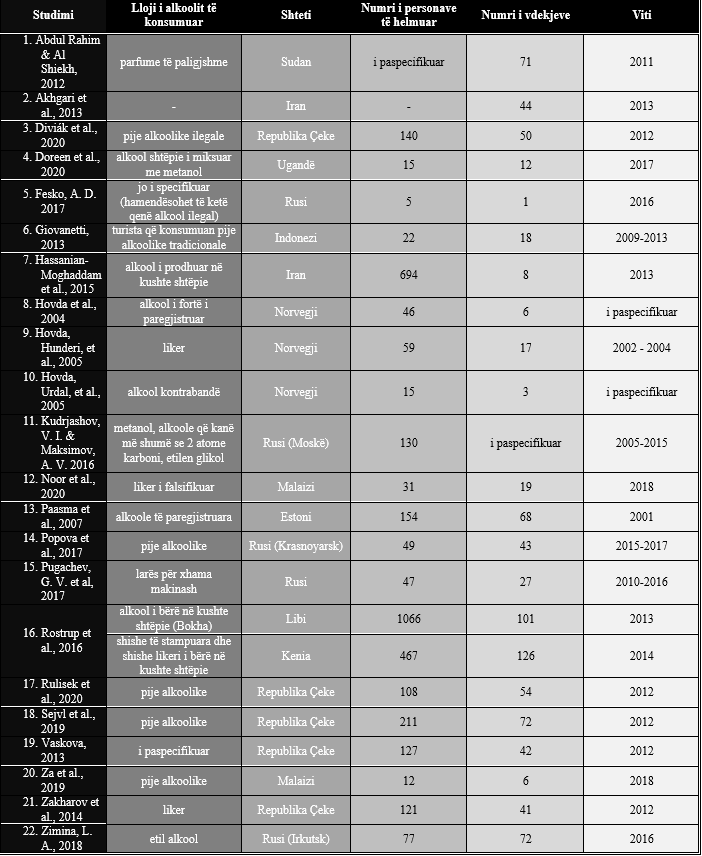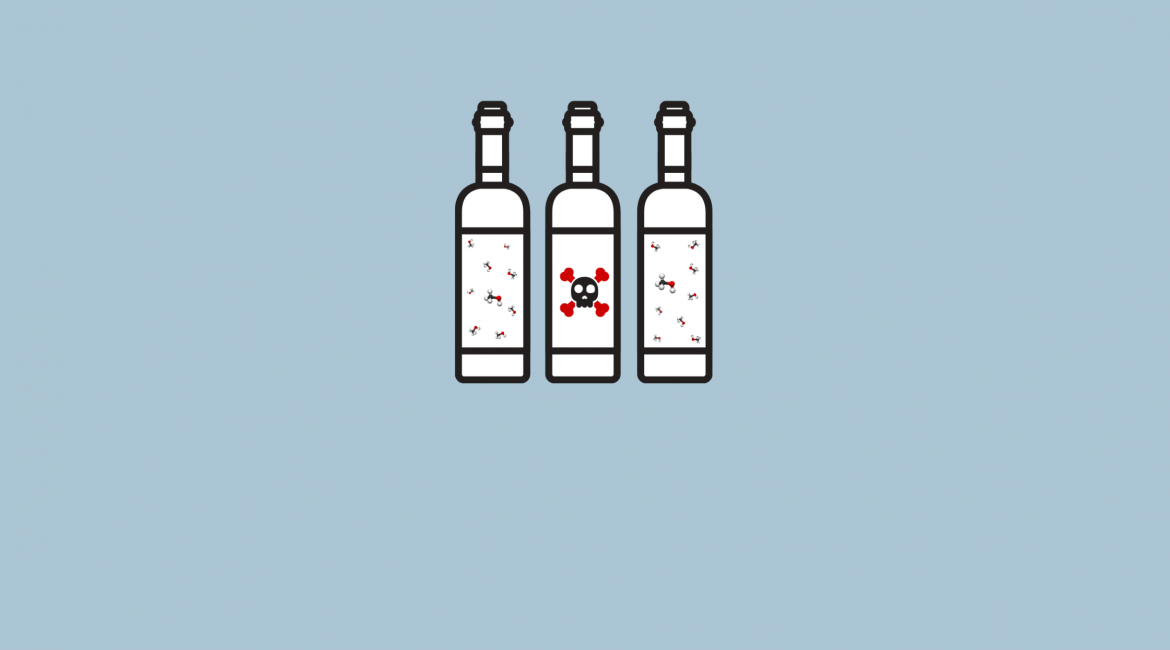Helmimet prej metanolit janë çështje serioze të shëndetit publik (1). Njohuritë mbi këtë temë mbeten të limituara për faktin se ky lloj helmimi shpesh neglizhohet ose keqdiagnostikohet, duke krijuar kështu paqartësi të cilat sjellin një nënraportim të situatës reale. Edhe pse trajtimi efektiv në disa vende të botës është i mundur, sëmundshmëria dhe vdekshmëria prej metanolit mbetet e lartë duke prekur në mënyrë të pabarabartë veçanërisht popujt me sfida ekonomike 2, 3, 5, 7, 8, 13, 16, 17, 21.Pavarësisht kësaj të fundit, helmime masive janë faktuar edhe në vendet e zhvilluara 4, 6, 9, 10, 11, 12, 14, 15, 18, 19, 20, 22, 23. Këto helmime, shpeshherë masive në numër, kanë adresuar paralelisht disa sfida (16) të cilat janë ‘rrënjë të së njëjtit trung’:
a) vonesa e shfaqjes së simptomave
b) ndryshueshmëri në simptomatologji
c) mungesë e eksperiencës klinike
d) vështirësi në konfirmimin diagnostik
e) mungesë në trajtimin klinik
f) sistem shëndetësor i ngopur me sfida shëndetësore
g) nivele të larta të vdekshmërisë prej metanolit.
Më poshtë po ju paraqesim një tabelë e cila pasqyron situatën globale në lidhje me disa prej helmimeve masive akute të metanolit prej konsumit të pijeve të pa regjistruara me përmbajtje alkooli etilik. Të dhënat janë gjeneruar prej databazave globale të cilat publikojnë hulumtime pas kalimit të filtrave shkencorë dhe i përkasin ngjarjeve të ndodhura në harkun kohor 2002-2018.

Referenca
- Lee CY, Chang EK, Lin JL, Weng CH, Lee SY, Juan KC, Yang HY, Lin C, LeeSH, Wang IK, et al. Risk factors for mortality in Asian Taiwanese patients with methanol poisoning. Ther Clin Risk Manag. 2014;10:61–7.
- Abdul Rahim, F. A. A., & Al Shiekh, A. (2012). Substance abuse and homelessness: mass methanol poisoning in Khartoum. Sudan Med J, 48(1), 1-6.
- Akhgari, M., Panahianpour, M. H., Bazmi, E., Etemadi-Aleagha, A., Mahdavi, A., & Nazari, S. H. (2013). Fatal methanol poisoning: features of liver histopathology. Toxicology and industrial health, 29(2), 136-141.
- Diviák, T., Dijkstra, J. K., & Snijders, T. A. B. (2020). Poisonous connections: A case study on a Czech counterfeit alcohol distribution network. Global Crime, 21(1), 51-73.
- Doreen, B., Eyu, P., Okethwangu, D., Biribawa, C., Kizito, S., Nakanwagi, M., Nguna, J., Nkonwa, I. H., Opio, D. N., & Aceng, F. L. (2020). Fatal methanol poisoning caused by drinking adulterated locally distilled alcohol: Wakiso District, Uganda, June 2017. Journal of environmental and public health, 2020.
- Fes’ko, A. D. (2017). Analiz jepidemiologii ostryh otravlenij i ih ishody [Epidemiological analysis of acute poisoning and their outcomes]. Repozitorij GomGMU. Retrieved from http://elib.gsmu.by/xmlui/bitstream/handle/GomSMU/4432/792-794.pdf?sequence=1
- Giovanetti, F. (2013). Methanol poisoning among travellers to Indonesia. Travel medicine and infectious disease, 11(3), 190-193.
- Hassanian-Moghaddam, H., Nikfarjam, A., Mirafzal, A., Saberinia, A., Nasehi, A. A., Masoumi Asl, H., & Memaryan, N. (2015). Methanol mass poisoning in Iran: role of case finding in outbreak management. Journal of public health, 37(2), 354-359.
- Hovda, K. E., Hunderi, O. H., Rudberg, N., Froyshov, S., & Jacobsen, D. (2004). Anion and osmolal gaps in the diagnosis of methanol poisoning: clinical study in 28 patients. Intensive care medicine, 30(9), 1842-1846.
- Hovda, K. E., Hunderi, O. H., Tafjord, A. B., Dunlop, O., Rudberg, N., & Jacobsen, D. (2005). Methanol outbreak in Norway 2002–2004: epidemiology, clinical features and prognostic signs. Journal of internal medicine, 258(2), 181-190.
- Hovda, K. E., Urdal, P., & Jacobsen, D. (2005). Increased serum formate in the diagnosis of methanol poisoning. Journal of analytical toxicology, 29(6), 586-588.
- Kudrjashov, V. I. & Maksimov, A. V. (2016). Analiz smertel’nyh otravlenij v Moskovskoj oblasti v period 2005-2015 gody [Analysis of fatal poisoning in the Moscow region in the period 2005-2015]. Sudebnaja medicina, 2, 32–35.
- Noor, J. M., Hawari, R., Mokhtar, M. F., Yussof, S. J., Chew, N., Norzan, N. A., Rahimi, R., Ismail, Z., Singh, S., & Baladas, J. (2020). Methanol outbreak: a Malaysian tertiary hospital experience. International journal of emergency medicine, 13(1), 1-7.
- Paasma, R., Hovda, K. E., Tikkerberi, A., & Jacobsen, D. (2007). Methanol mass poisoning in Estonia: outbreak in 154 patients. Clinical toxicology, 45(2), 152-157.
- Popova, E. A., Ljubchenko, A. A., Shivrina, T. G., Rahmanova, E. A., Habarova, O. I., Bol’shakova, M. A., et al. (2017). Kliniko-laboratornye pokazateli, osobennosti i rezul’taty lechenija pacientov s otravleniem metilovym spirtom [Clinical and Laboratory Parameters, Features and Results of Treating Patients with Methyl Alcohol Poisoning]. Vestnik Hakasskogo gosudarstvennogo universiteta im. N.F. Katanova, 19, 126–129.
- Pugachev, G. V., Pugacheva, I. V., Begunov, V. A., & Vasina, N. N. (2017). Analiz ostryh otravlenij metanolom v otdelenii toksikologii za 2010-2016 gg [Analysis of acute methanol poisoning in a toxicology department for 2010-2016]. Aktual’nye voprosy diagnostiki, lechenija i reabilitacii bol’nyh, Proceedings of the XIX anniversary interregional scientific-practical conference dedicated to the 40th anniversary of PIUV – a branch of FGBOU DPO RMANPO of the Ministry of Health of Russia. Retrieved from https://dep_pediatr.pnzgu.ru/files/dep_pediatr.pnzgu.ru/c_fakepath_piuv_2017.pdf
- Rostrup, M., Edwards, J. K., Abukalish, M., Ezzabi, M., Some, D., Ritter, H., Menge, T., Abdelrahman, A., Rootwelt, R., & Janssens, B. (2016). The methanol poisoning outbreaks in Libya 2013 and Kenya 2014. PloS one, 11(3), e0152676.
- Rulisek, J., Waldauf, P., Belohlavek, J., Balik, M., Kotikova, K., Hlusicka, J., Vaneckova, M., Seidl, Z., Diblik, P., & Bydzovsky, J. (2020). Health-related quality of life determinants in survivors of a mass methanol poisoning outbreak: six-year prospective cohort study. Clinical toxicology, 58(9), 870-880.
- Šejvl, J., Barták, M., Gavurová, B., Mašlániová, M., Petruželka, B., Rogalewicz, V., Zacharov, S., & Miovský, M. (2019). Public health response to methanol mass poisoning in the Czech Republic in 2012: a case study. Central European journal of public health, 27(Supplement), 29-39.
- Vaskova, H. (2013). Quantitative evaluation of methanol content in beverages based on raman spectral data. Mathematics Computers Biology Biomed informatics No, 81, 85.
- Za, M. A., Hazariah, A. H., Rao, G., & Zailiza, S. (2019). Methanol outbreak in the district of Hulu Langat, 2018. The Medical journal of Malaysia, 74(5), 413-417.
- Zakharov S, Pelclova D, Urban P, Navratil T, Dilblik P, Kuthan P et al. (2014) Czech mass methanol outbreak 2012: epidemiology, challenges and clinical features. Clin Toxicol (Phila). 52(10):1013–24.
- Zimina, L. A., Zhogolev, P. V., Semjonov, A. V., Leljuh, T. D., Lunjonok, S.V., Maslauskajte, L. S., et al. (2018). Analiz letal’nyh sluchaev massovogo otravlenija metilovym spirtom v g. Irkutsk[Analysis of fatal cases of mass poisoning with methyl alcohol in the city of Irkutsk]. Sciences of Europe, 32, 28–35.





